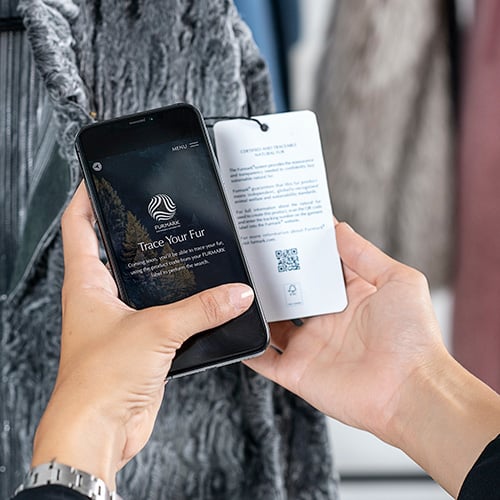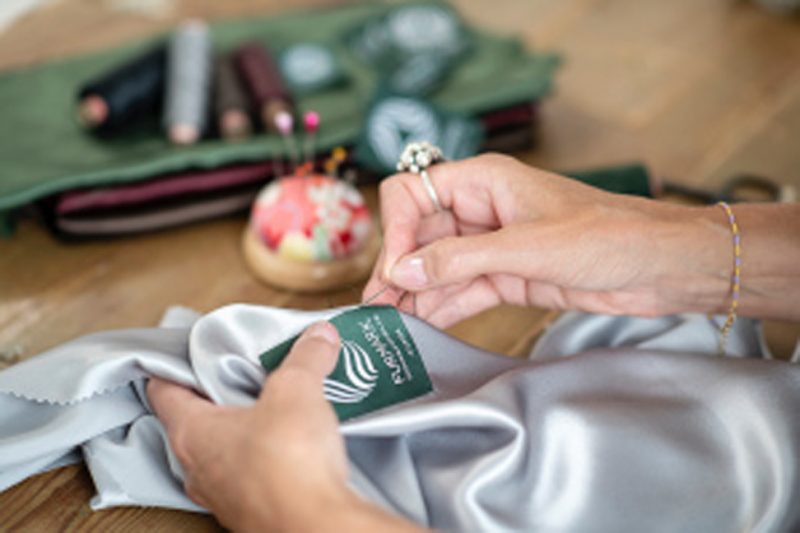AS SEEN ON WWD:
“The IFF said the new, QR-coded swing tags, which map the history of a fur garment, will be a ‘game changer.'”

LONDON — Every fur has a tale to tell and now consumers will be able to learn the story of the items they’re purchasing via the new Furmark traceability tag, which begins rolling out this week to coincide with the arrival of the fall 2021 collections.
The Furmark swing tag comes with a QR code that maps the history of a garment, from farm to dyer, manufacturer and shop floor, according to the International Fur Federation, which worked closely with luxury groups including LVMH Moët Hennessy Louis Vuitton and Kering on the standards.
Four years in the making, Furmark will be the only globally recognized fur certification, according to the IFF.
Certified products will carry a unique alphanumeric label code that provides full traceability details including fur type and origin; animal welfare program; manufacturer, and place of manufacture. Each step of the certification process is recorded via a customer-accessible traceability component, ensuring transparency across the supply chain.
The Furmark label only incorporates wild or farm-raised natural fur from top animal welfare programs, including WelFur, the first animal welfare program to be promoted through the European Commission’s Self-Regulation and Co-Regulation Initiative.

Furmark-certified products can only be manufactured by businesses that have passed due diligence checks conducted by brand protection and anti-counterfeiting experts, according to the IFF.
IFF’s chief executive officer Mark Oaten believes it will be a “game changer” both for the trade, and for the consumer.
“If people had doubts about buying or wearing natural fur, then they have been answered with Furmark,” he contended, adding that the new label will also add a layer of protection for consumers buying furs online. The new swing tag will also guarantee that fake fur is not erroneously labelled as real.
“Our centuries-old trade is undergoing its most significant transformation to date, and traceable, sustainable products represent the real alternative to fast fashion,” Oaten said.
“It guarantees animal welfare and environmental standards and demonstrates our shared ambition to deliver a transparent, easy-to-understand certification. It means, in short, that people can confidently buy sustainable, natural fur,” he added.
In a video interview, Oaten underlined that the IFF had worked closely with both LVMH and Kering on Furmark’s development and both groups’ brands will be working exclusively with the label, if they choose to carry fur in their collections.
Brands can choose to add the swing tag to their products, or have the new Furmark label sewn into the garment.
The IFF is also working with Moncler, Galeries Lafayette and Russia’s Snow Queen stores, in addition to a series of smaller retailers.
Oaten said LVMH and Kering in particular “brought us huge expertise and knowledge.”
He said the IFF worked with Kering in Namibia where SWAKara (South West Africa Karakul) lamb fur is produced by small farmers. They worked on issues such as predator management, inspection and machinery standards, and supporting local communities and conservation programs.
The IFF added that LVMH “has brought invaluable expertise and time over the past four years to help develop the Furmark program, alongside other industry experts and stakeholders and sustainability professionals,” who offered feedback and helped to shape standards and certification schemes.
Each animal welfare and sustainability program has a detailed, independently developed and science-based protocol, or standard. The respective programs are then subject to third-party assessment and certified by a recognized certification body. Active enforcement is ensured via visits and assessments. Those that do not meet standards are excluded from the certification program and the Furmark system, according to the IFF.
Asked about the costs of signing up to the new program and the various inspection procedures it involves, Oaten said they will be spread throughout the value chain, and it will be up to the brands to pass on any price increases to the consumer. He said if prices do rise, though, it would be by “a handful of euros.”
The IFF said the hope is that Furmark “will change how fur is seen and open up fur to a whole new market and audience. The sector, industry leaders, scientists, sustainability leads and welfare experts have come together to agree a set of recognized standards — based on science, independent inspection and transparency — and a global labeling regime that is set to modernize natural fur.”
The launch of Furmark comes as increasing numbers of brands and retailers are doing away with fur.
As reported in August, Mytheresa said it would no longer carry fur as of the spring 2022 season.
In July, the Montreal-based luxury outerwear brand Moose Knuckles launched a sustainability program that included a commitment to stop using fur by the end of 2022. The move came on the heels of Canada Goose and Neiman Marcus’ plans to drop fur.
According to a survey conducted earlier this year on behalf of the IFF, global research showed that 70 percent of the public is “open” in some form to designers and brands using natural fur.
A majority, 65 percent, of those surveyed responded positively to Furmark and 56 percent said it “very positively” or “positively” changed their view of natural fur.
Some 5,000 adults across key markets in the U.S., the U.K., Italy, France and Spain were surveyed between March and April of this year by Mitchla Marketing.
The IFF was established in 1949 and represents and regulates the global fur sector. It has 56 member associations in more than 40 countries around the world.
Moves by the IFF to establish a traceability standard and set Furmark products apart mirror those of the diamond industry, and De Beers in particular, which had long been criticized for not revealing enough information about its sourcing and supply chain practices.
In 2008, De Beers launched Forevermark, the brand of diamonds inscribed with microscopically small serial numbers and sold through about 2,000 high-end stores worldwide.
De Beers describes the diamonds as “rare and responsibly sourced” and says that less than 1 percent of the diamonds it mines are eligible to carry the Forevermark label.




